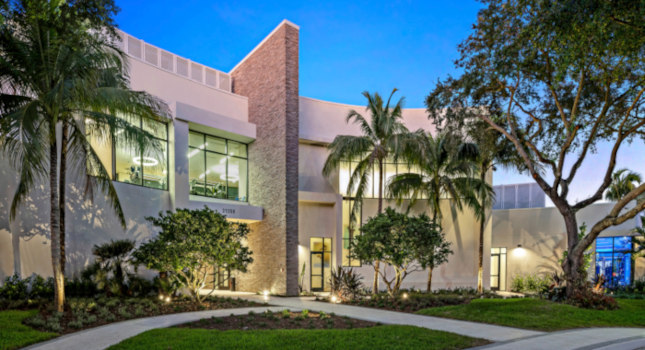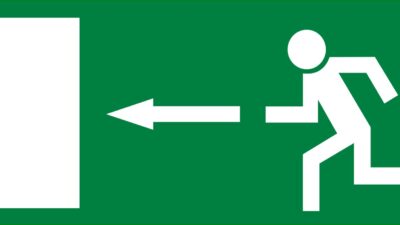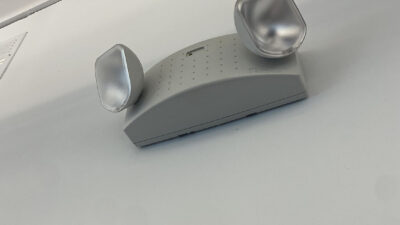Understand the NEC requirements related to component failure in emergency lighting fixtures

Learning Objectives
- Understand the history and intent of code requirements related to avoiding total darkness in emergency lighting scenarios.
- Become familiar with different strategies for compliance with the code requirements related to emergency lighting scenarios.
- Know how to select and document the solution(s) for avoiding total darkness in emergency lighting scenarios best suited for a given project.
Emergency lighting insights
- NFPA 70: National Electrical Code provides guidance on designing emergency lighting systems.
- Emergency lighting includes lighting fixtures and exit signs to guide occupants in the case of an emergency.
NFPA 70: National Electrical Code Article 700.16 contains code requirements related to the avoidance of total darkness in emergency lighting conditions. Emergency illumination may be provided by batteries integral to luminaires, generator back up or lighting inverters. Some emergency illumination luminaires are controlled with adjacent normal lighting under normal conditions and fully energized under emergency conditions, while other emergency luminaires are normally off and only energized under emergency conditions.
Updates to NEC in 2020 account for the differences in lighting technology that have emerged since the widespread adoption of LED luminaires. Legacy sources such as fluorescent, incandescent and high-intensity discharge luminaires had lamps that were separate from the luminaire itself. The light source in LED luminaires is a diode integral to the luminaire though, not a separate lamp. Updates to the indicated portion of the NEC were needed to ensure the language was applicable to LED luminaires.
Many engineers remain unaware of how these changes affect design considerations for emergency lighting. While the changes may seem minor, they must be accounted for at the beginning of a project or else risk costly delays in equipment ordering or occupancy. Failure to follow these new requirements can lead authorities having jurisdiction to require rework, which can include reopening finished walls or ceilings, running new conduits, retrofitting power supplies and installing new equipment.

The scope of this article will specifically focus on the portion of NEC Article 700.16 related to system reliability. It should be noted that this article is not intended to be an exhaustive interpretation covering all requirements related to emergency illumination.
There are other code requirements applicable to emergency lighting contained in, for example, the NEC, NFPA 101: Life Safety Code and the International Building Code that are outside the scope of this article that the engineer of record must be familiar with to ensure a fully code-compliant design.
Emergency lighting code changes
NEC requirements related to the failure of individual lighting elements were first introduced in 1956 and most recently updated in 2020. The 2017 and 2020 code language can be seen below. Note particularly the change in 2020 NEC 700.16(B) to the “failure of any illumination source” compared to the 2017 wording of the “failure of any individual lighting element, such as the burning out of a lamp.”
2017 code language:
700.16 Emergency Illumination
Emergency illumination shall include means of egress lighting, illuminated exit signs and all other luminaires specified as necessary to provide required illumination.
Emergency lighting systems shall be designed and installed so that the failure of any individual lighting element, such as the burning out of a lamp, cannot leave in total darkness any space that requires emergency illumination.
Where high-intensity discharge lighting such as high- and low-pressure sodium, mercury vapor and metal halide is used as the sole source of normal illumination, the emergency lighting system shall be required to operate until normal illumination has been restored.
Where an emergency system is installed, emergency illumination shall be provided in the area of the disconnecting means required by 225.31 and 230.70, as applicable, where the disconnecting means are installed indoors.
2020 code language:
700.16 Emergency Illumination.
- A) General. Emergency illumination shall include means of egress lighting, illuminated exit signs and all other luminaires specified as necessary to provide required illumination.
N (B) System Reliability. Emergency lighting systems shall be designed and installed so that the failure of any illumination source cannot leave in total darkness any space that requires emergency illumination. Control devices in the emergency lighting system shall be listed for use in emergency systems. Listed unit equipment in accordance with 700.12(I) shall be considered as meeting the provisions of this section.
N (C) Discharge Lighting. Where high-intensity discharge lighting such as high- and low-pressure sodium, mercury vapor and metal halide is used as the sole source of normal illumination, the emergency lighting system shall be required to operate until normal illumination has been restored.
N (D) Disconnecting Means. Where an emergency system is installed, emergency illumination shall be provided in the area of the disconnecting means required by 225.31 and 230.70, as applicable, where the disconnecting means are installed indoors.
Interpreting NEC Article 700.16
NFPA 70-2017 Article 700.16 and the 2020 edition of Article 700.16(B) are intended to account for possible manufacturing defects of the light fixture, ensuring that a space containing emergency illumination would not be left in total darkness if one component in an emergency fixture was to fail.
With legacy source types, this code section was frequently accounted for by having emergency fixtures furnished with two ballasts and two lamps. If one ballast and/or lamp failed, the fixture would still produce some light and the space in question would not be left in total darkness under emergency conditions.
The updated wording in the 2020 code reflects the industry’s movement away from legacy source types to LEDs by revising the wording from “… any individual lighting element, such as the burning out of a lamp …” to “… any illumination source …”.
There is a line of thinking that says an LED fixture with multiple diodes would inherently comply with the 2020 edition of NEC because the wording “any illumination source” only applies to the diodes themselves. A multidiode LED fixture that has one diode fail can still provide light via the remaining diode(s).
However, lighting designers have had experience with the authority having jurisdiction interpreting this section of code as meaning that the driver also cannot be a single point of failure for the fixture. If the driver fails, then no light is coming out of the fixture and thus the illumination source failed. As such, the conservative interpretation that neither the driver or light board can be a single point of failure for the fixture is assumed for this article.
How to handle emergency lighting scenarios
There are multiple ways to comply with this code requirement. Some are listed below, although the list of strategies indicated is not necessarily exhaustive and there may be additional ways to achieve project compliance.
Scenario 1: Multiple fixtures in an interior space
An interior space that has more than one emergency fixture will typically comply with this portion of code. Should one emergency fixture fail, the other emergency fixture(s) in the space would prevent the space from being in total darkness (see Figure 2).

Scenario 2: One fixture in an interior space with glass wall
If an interior space has only one emergency fixture, but additional emergency fixtures are on the other side of a glass wall or door, it is reasonable to conclude that light from one of the adjacent emergency fixtures shining through the glass wall or door would prevent the space from being in total darkness in the event of an emergency.
Scenario 3: Exterior space with site lighting
For exterior door applications where emergency lighting is provided by a wall pack, recessed downlight or some other form of lighting right outside the door, this section of code can be complied with if there are bollards, pole lights or some other form of site lighting in the area that are also on emergency power. The adjacent site lighting backed up by emergency power would keep the space from being in total darkness should normal power and the fixture by the door both fail (see Figure 3).

Scenario 4A: Exterior space with no site lighting (single driver)
A more challenging situation related to this portion of code is an exterior door that has only one emergency fixture adjacent to it without any other site lighting in the vicinity. A common example of this is an exterior door with one emergency wall pack or sconce above it with no other building mounted lighting or site lighting nearby. One possible solution is to add another emergency illumination source near the door, either by adding a second normally on emergency fixture or by adding a normally off exterior emergency lighting unit.
Scenario 4B: Exterior space with no site lighting (dual driver)
Sometimes aesthetics or practicality make those options not preferred though. In those situations, a good solution is to specify one emergency fixture with dual drivers and dual light engines (see Figure 4). That way if one driver or light engine fails, half of the fixture will still illuminate and the space will not be left in total darkness.

Understanding manufacturer offerings
Multiple manufacturers offer exterior fixtures that have an option of being provided with dual drivers and dual light engines. They frequently are not available with integral battery backup or integral control sensors or receivers, as the two separate internal circuits would make the connections cumbersome and the physical size of the fixture larger than typically desired. The two drivers can be controlled separately or tied together external to the fixture and controlled by a common remote switch, photocell or time switch. It is typically a good practice to provide notes and/or a detail on the plans to clarify how these fixtures should be connected to ensure the final install matches the design intent.
Interior rooms (Figure 2) requiring emergency illumination that only have one light within and no glass walls or doors are another situation to pay special attention to on a per-project basis to determine the best course of action. Small connecting hallways, vestibules and rooms with electrical panels are common examples of this situation.
In the case of these smaller interior rooms, an interior lighting unit such as a “bug-eye” type fixture, if it meets the requirements of Article 700.12(I), would comply with Article 700.16(B) without the general lighting in the room being backed up by emergency power. Manufacturers are generally aware of the requirements listed in Article 700.12(I) and most emergency lighting units available do comply with those requirements.
In situations where adding a second light source and/or adding an emergency lighting unit to the room is not preferred, there are some manufacturers that offer strip lights with the option of having dual drivers and dual light engines (see Figure 4), similar to the approach indicated above for select exterior door applications. If such a fixture were provided in the space, the failure of one driver or light engine would not leave the space in total darkness.

Similar to the exterior fixtures discussed above, these fixtures are usually not available with integral battery backup or integral control sensors or receivers. The lines coming off each driver can usually be controlled separately or tied together outside the fixture and connected to a common control device such as a switch. It is typically a good practice to provide notes and/or a detail on the plans to clarify how these fixtures should be connected as well to ensure the final install matches the design intent.
In conclusion, designers and engineers should pay close attention to NEC Article 700.16 and include features in their project to ensure code compliance. While some AHJs may not be in the habit of putting emergency lighting under scrutiny, this should not be counted on. For the safety of occupants and a smooth occupancy process, it’s important to get this right the first time.



